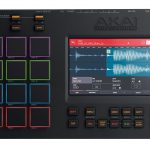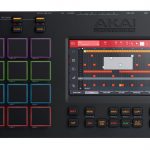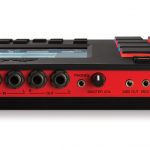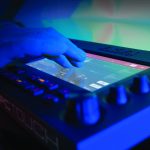As technology marches onwards, each wave brings a little something extra to the table. Drum machines migrated from simple LED numeric displays to actual screens with lines of text. Then came full colour screens with actual waveforms, offering more visual feedback than ever before. And now we move to tactile interaction with a groove box via a rather lush 7″ screen. The MPC Touch might sound like some iPad thingy, but this is about as far away from that as possible.
Some words:
AKAI PROFESSIONAL BREAKS THE WORKFLOW BARRIER WITH THE REVOLUTIONARY MPC TOUCH
The newest addition to the legendary MPC series re-writes the rules with an intuitive controller featuring multi-touch display for an immersive production experience
Ash Vale, UK (October 7, 2015) — Akai Professional, a leading manufacturer of music production equipment today announces the introduction of the MPC Touch, the newest and most advanced member of their legendary MPC product line. The touch-screen controller is the result of painstaking engineering development, detailed customer research and user feedback. The result is the most capable and user-friendly music production controller Akai Professional has developed to date.
The Touch introduces a new approach to music production with an ultra fast and super intuitive workflow, powered by a radiant 7″ colour multi-touch display. Literally grab and pinch waveforms, draw midi events, adjust envelopes, chop samples, add effects and precisely set your controls using your fingertips. Combined with the classic MPC feel, sound and award-winning pads, the Touch embodies the best elements of our past while taking music production gear into the future.
Features:
- 7″ colour multi-touch Display
- 16 velocity-sensitive thick, fat MPC pads with RGB backlighting
- 2-in/2-out audio interface
- Step Sequencer with touch interface
- XYFX control adds effects, adjusts sound dynamics in real time
- Phrase Looper, enables connection of any instrument to create loops
- Pad Mixer for setting levels, stereo panning and adding VST effects
- Sample Edit control, for trimming, chopping and processing your samples
- 4 new, performance-ready touch-sensitive controls
- Data Encoder knob, for push-and-twist control of display parameters
- Includes MPC software with over 20 GB of sound content
“Our new MPC Touch is an incredibly noteworthy event in the evolution of the Akai Professional product lineup. Years of research, customer feedback and cutting-edge engineering development has led directly to the most capable and innovative MPC we’ve ever offered,” said Dan Gill, Product Manager for Akai Professional. “We’re known for the excellence and music-making capability of our MPC family. It’s the backbone of what we do. The MPC Touch breaks new ground in music production in terms of ease of use and on-board capability. We’re excited and proud to offer it to modern musicians everywhere.”
The Akai Professional MPC Touch will be available November 2015 at Akai Professional dealers and will ship with an MSRP of £499.99.
LESS BUTTONS — MORE SCREEN
It’s a multi-touch screen — worth differentiating that right now from a simple touch/slide control interface. So there are possibilities beyond pressing a button or tabbing screen to screen. Also, should they take customer feedback seriously, it means that they can change controls as they see fit too. Obviously I have no idea how hackable it is, but I’m sure some smart model can get to work on a JJOS style interface, if one is needed of course.
Sadly, and if I understand it correctly, you’re still tethered to a laptop. They’re no real brain inside this thing, and the screen is probably driven directly from your computer. That said, looking at the display, you can probably put your computer some distance away and work with the MPC Touch in isolation. The workflow implementation looks to be pretty complete.
I’ll be honest, when I read the press release for the first timeliest week, I was unimpressed. “Why can’t they just build something to take an iPad?” I thought, but having seen the pictures and watched the video, I can see the attraction of the MPC Touch. The screen allows a level of control not seen before, as well as visually having everything you need at hand.
“THIS IS JUST THE BEGINNING”
I picked up on this parting shot from the promo video. This format is clearly the future of the MPC line, and is definitely far enough away from the originals to be considered as something else rather than paying homage. But what more can we expect? We definitely want to see a proper standalone device. Akai Pro needs to work on not requiring a laptop and having an embedded solution, as well as scaling down the MPC Touch into something akin to the MPC Studio, but not so damned shiny.
Summing up, the Akai Pro MPC Touch will be available in November with price tags of £499/$799 (probably cheaper on the street in the US). I’d say click here for more info, but the Akai Pro site is groaning under the strain. Good luck.













It’s like the maschine studio. Looks great.
Except most of the features will be accessible via the touchscreen instead of physical knobs and buttons. Touchscreens are great for expressive effects (that’s why I own a Kaoss Pad 3, Zero8 and TB-3), but have you tried iMPC or any other virtual instruments in iOS-Android? The response is certainly not the same and less precise. And we’re talking about some of the best touchscreens on the market. Sorry to sound pessimist, but while it’s all great to have most of the software features crammed into a single controller, physical controls are more important to me, and I guess it’s the same for a lot of musicians, since it’s what they’ve used since they started. Maybe the new generation will be all over this, though. Maybe I’m just too old for this sh**.
I’ve just counted 16 BIG rgb led pads (Akai = industry standard), 22 smaller knobs for workflow support + 5 rotary knobs, as well as a VERY nice looking hi res touch screen, all within a very compact footprint. Seems to me this product offers a lot of tactile / physical control..
If it had a standalone mode, Akai would have screamed it from the top of their lungs. Too bad they used “Return of the king” for this, and not the next standalone MPC they will eventually build because everyone’s asking for it. I guess this will appeal to newcomers who don’t already have an audio interface, but I don’t see pros who are used to knobs, buttons and faders change their workflow for a small touchscreen. Is it 2015 already Akai? Windows embedded should be used for a standalone instrument, not to be tethered. People are willing to pony up for it. What are they waiting for?
still arttached to a laptop, thats not what the MPC community wants, they want a STANDALONE MPC, why the hell aren’t these cunts listening to their customers????
the MPC renaissance was a big disappointment as well, It won;’t be long before the annoying laptop can be ditched, so Nomark needs to listen to the community for 1 sec of their precious time
Whoa Nelly! There is still a massive market for MPC (or MPC style) controllers. Ever heard of a product called Maschine? It sold okay.
MPC software has also come a long way since the Ren and Studio dropped, and if imagine its development is far from over
Maschine ain’t an MPC, the MPC is legendary for it’s standalone Machines like the 3000.
Put the software into the device, not relying on external hardware will be a blessing, you obviously are oblivious to what the MPC fans want.
Lol. Okay mate. So, Akai Pro stopped producing standalone MPC’s years ago because they were massive sellers, right?
That sounds like a sound business strategy.
Hate on.
You don’t get it, the MPC community wants standalone, not a slave machine to an annoying laptop or PC. that’s for the Maschine fanboys.
I’m pretty sure new standalone will sell, whats so exciting about slave machines? You don’t prefer independence? Ok then good for you. I know one day Akai will get back to standalone, just as DJing will be without the need of a laptop in the future.
I do get it. I read MPC Forums. I speak with MPC users every day. I understand what you’re saying.
What you need to understand is that the BIGGEST market is controllers, it just is. MPC die-hards who crave the standalone MPCs are a niche market in a niche market – and a lot of them are already locked in and not moving from their MPC60, 3000, 4000 or 2500 etc. Perhaps this product isn’t for that kind of producer – you can’t please all the people all the time.
Me personally, no, I don’t prefer “independence” – I prefer power and options, but I understand that many other users don’t, and that’s cool.
I do get it. I read MPC Forums. I speak with MPC users every day. I understand what you’re saying.
What you need to understand is that the BIGGEST market is controllers, it just is. MPC die-hards who crave the standalone MPCs are a niche market in a niche market – and a lot of them are already locked in and not moving from their MPC60, 3000, 4000 or 2500 etc. Perhaps this product isn’t for that kind of producer – you can’t please all the people all the time.
Me personally, no, I don’t prefer “independence” – I prefer power and options, but I understand that many other users don’t, and that’s cool.
ok fare enough
Don’t forget that Roland put out the TR-8 not that long ago, even if the market is niche they do sell to the die-hard fans.
Just as Technics 1200 will sell if they relaunch it, even an SP-1200
Word. I don’t really see how a 13″ MBP and ONE CABLE between them is that big of an irritation vs. a hard-wired standalone. I mean, you can really think of it as a standalone w/ a large, breakout screen. Everyone has this fantasy of taking their hardware to, what…. a desert island?
I have my OP-1 for standalone, off-the-cuff sketching, sampling, etc. on the sofa.
For power, options, bells & whistles (3rd party effects, etc.), I love the MPC Touch w/ 1.9.1 software. Runs like a champ.
No need for that language here…or anywhere really – I’m guessing Mark will censor / remove?
Words are tools used to convey meaning. They aren’t magic. Stop being so sensitive.
aww cootchie cootchie, my sincere apologies
Renaissance 2 on its way perhaps?
I really loved the workflow on my mpc1000. I would basically like to have a standalone mpc that is battery powered and with similar ableton export functionality as korg offers.
Dear AKAI, please tell me you are working on a Serato sub-controller with the same form factor as this product: 2×8 performance pads, rotary knobs and buttons for effects and other functionalities like transport control, flip, key sync/shift, etc. Plus this very nice looking looking touch screen for library, waveforms, parameter display. Like a DDJ-SP1 on steroids. Build it and it will sell as hotcakes.. :)
This as a stand-alone, take my money!
I already have an MPC Studio I don’t need another controller.
If it were stand alone, I think it would have made a huge impression. The touch screen idea is cool for expressiveness, but Id like to see more knobs as well. It looks cool, but its nothing that we really haven’t seen. Im excited to see what NI cooking up. It definitely would be NI that made something innovative and standalone before anyone else, in my opinion. You can get a sense that they’re going in that direction.
What happens if your touchscreen breaks it’s useless. These manufacturers pushing touch should be offering more than a 1 year warranty. 2-3 should be the norm.
The same goes for the XDJ.
Love the look, about time they finally brought their design language over from Push.
I’ll just leave this here
I did wonder what else could be done with that screen.
Library display & search with pop-up keyboard, Effect selection, parameter display & X/Y effects, Track scrubbing & beat gridding… For Serato DJ 1.8.3 please… :)
Library display & search with pop-up keyboard, Effect selection, parameter display & X/Y effects, Track scrubbing & beat gridding… For Serato DJ 1.8.3 please… :)
Now that would be lovely
Now that would be lovely
Now that be possible and cheaper with an ipad mini + is202 dock + mpd232 controller and serato remote or splashtop2 (over wifi or usb connection). Also this combination could be true standalone with impc pro or djplayer…
Dont get me wrong I would LOVE a standalone equivalent but the built in audio and much bigger screen (touch or not) make it a much better MPC Studio, particualrly now the MPC software has matured. MY only quibbles as a long term MPC user are the strange positioning of the note repeat and erase buttons (dont really want to reach over the pads for those), the rear mounted volume/rec gain controls and the lack of cursor buttons should I not want to use the touch screen.
Just as I bought a Maschine MK2 yesterday. I think NI will drop a standalone unit. I recall MK saying that that’s were NI are heading in a talk with point blank
IMO £500’s a lot of cash for something that’s useless without a computer.
IIRC the MPC1000 was around £500 – but was completely stand alone, with 6 audio outs, digital I/O, two MIDI in and two MIDI out, plus USB for transferring samples and the option for an internal HDD. Much better value.
The Amazon Fire 7″ tablet is £50, and that’s with it’s own OS and RAM. I can’t see how a few pads, knobs and buttons adds £450 to that.
I see the ideal price for the MPC Touch as maybe £200 tops.
IMO £500’s a lot of cash for something that’s useless without a computer.
IIRC the MPC1000 was around £500 – but was completely stand alone, with 6 audio outs, digital I/O, two MIDI in and two MIDI out, plus USB for transferring samples and the option for an internal HDD. Much better value.
The Amazon Fire 7″ tablet is £50, and that’s with it’s own OS and RAM. I can’t see how a few pads, knobs and buttons adds £450 to that.
I see the ideal price for the MPC Touch as maybe £200 tops.
It’s all about economies of scale. I just googled some sales figures and in 2014 Amazon sold 70+ million Kindles. I can guess at possible sales numbers for the MPC Touch, and I reckon it’ll be about 0.02% of that figure. For a touch screen device, with an audio interface, the price for the MPC Touch seems fair.
agreed , you can’t compare mass market devices with something as niche as controller for a vey niche industry in terms of sales numbers no matter what brand you put on it.
My initial comparison was the MPC1000. Same company, same price, much more hardware for the money.
The Fire was just used as an example of how touch screens are ubiquitous now and not expensive tech, so having the screen doesn’t justify the price (IMO).
putting aside the cost of the touch screen , you maybe are forgetting the cost of the now , very sophisticated software, and the 20 GB of named 3rd party sound library? Just sayin’….
so….. Maschine Studio is £229 MORE than MPC touch and is without a sound card or a touch screen and is presumably also “a lot of money for something that is useless without a computer ” ? how about ROLI seaboard at £2000 , useless without a computer etc etc etc
How come is this more expensive than MPC Renaissance? Also, knowing Akai problems with writing proper software, I wonder how long it will take them to make it actually usable… Glad at least the MPC Software itself works much better now and last few updates were all huge improvements, so there’s hope after all. I know I’d like to try it myself!
It seems to be a pricing anomaly. It’s cheaper than the Renaissance in the UK.
I think MPC Ren is on sale in the US right now. Touch is cheaper than Ren in Australia also.
Unfortunately, the *most* exciting thing about this announcement are the words, “This is just the beginning.”
Unfortunately, the *most* exciting thing about this announcement are the words, “This is just the beginning.”
I’ll use the sound of my balls hitting the ground when I read “you’re still tethered to a laptop” as a snare.